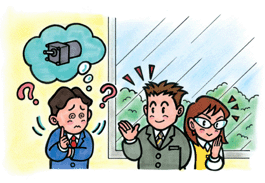Why Does the Rotation Direction Differ Depending on the Gear Ratio?


-

New Employee Mmm... Mmm...
-


What's bothering you?

-

New Employee Ah, Mr. Vex, Ms. Ori! Please listen!
I received an inquiry from a customer who said, "I replaced the gearhead with another with a larger gear ratio for low speed operation, and it started to rotate in opposite direction." It's strange incident!! They haven't touched the wiring...and the capacitor is still there... I'm wondering if there's another cause. -

What was the product name?
-

New Employee I replaced the 5GU60KB gearhead that was attached to the 5IK60GU-AWJ motor with a 5GU75KB gearhead.
-

Have you looked at the general catalog?
-

New Employee Yes. I've looked through the whole catalog... Is there a point to see?
-

Did you notice that the "Permissible Torque When Installing Gearheads" table in general catalog 2004/2005 (page A-41) is color-coded according to the gear ratio?
-

New Employee Oh, you’re right... Why is that?
-

The gear ratios labelled in green indicate that they rotate in the same direction as the motor shaft, while the uncolored gear ratios indicate that they rotate in the opposite direction to the motor shaft.

-

New Employee Eh? Why does the rotation direction differ depending on the gear ratio?
-

The gearhead uses gears to decelerate, right? The ratio of the number of teeth in the gear is the gear ratio, and in order to increase this gear ratio, it is necessary to increase the ratio of the number of teeth. This means that the gears on the drive side should have a smaller number of teeth, and the gears on the non-drive side should have a larger number of teeth.
-

New Employee Yes.
-

However, there is a limit reducing the number of teeth, and even increasing the number of teeth has limitations due to the dimensions of the motor's frame size. Therefore, we are designing a gearhead with a large reduction ratio by increasing the number of gear reduction stages. That's why the number of stages differs depending on the gear ratio, with odd numbered stages rotating in the opposite direction of the motor shaft, while even numbered stages rotate in the same direction as the motor shaft.
-

New Employee I see... Got it! Thank you very much!! I will call the customer as soon as possible.
-

If you have any other questions, you can ask me anything.
-

Well done, Vex. You're doing a great job teaching the new employee.
-

I wish. I don't deserve that much praise. I'm just doing what a good senior employee would do!
-

New Employee Huh?
-

What's wrong?
-

New Employee Gearheads are supposed to have higher torque the higher the gear ratio is, right?
-

That's right. Why?
-

New Employee If you look at 50 Hz under "Permissible Torque When Installing Gearheads", it is the same torque from 1/75 up to 1/180. Why is that?
-

Eh?? Ah, you’re right! I wonder why…?
-

You still have a lot to learn, Vex.
A gearhead's output torque increases in proportion to increases in the gear ratio, but there is a limit to the amount of load torque that can be applied to the gearhead depending on the gear material and other conditions. This torque limit is called maximum permissible torque, and the value in the case of the 5IK60GU-AWJ and 5GU□KB, is 20 N·m. -


New Employee Ohhh, I see.
-

Also, gearhead torque does not just increase in proportion to the gear ratio. It is also related to the transmission efficiency of the gearhead.
-


New Employee The transmission efficiency?
-

Yes, that's the efficiency with which torque is transferred from gear to gear. 100 % transmission is impossible if there is loss of teeth meshing or bearings, etc. Vex was talking about increasing the number of gear stages to increase the gear ratio. By increasing the number of stages, the transmission efficiency decreases. So don't forget about this transmission efficiency when calculating the gearhead's torque.
-

New Employee Thank you very much, Ms. Ori!
-

No problem. You're very welcome. And good luck to you!
-

New Employee Yes! Thank you very much!!
-

*sigh*. I'm not quite there yet. Ms. Ori, I hope you keep on teaching me a lot!